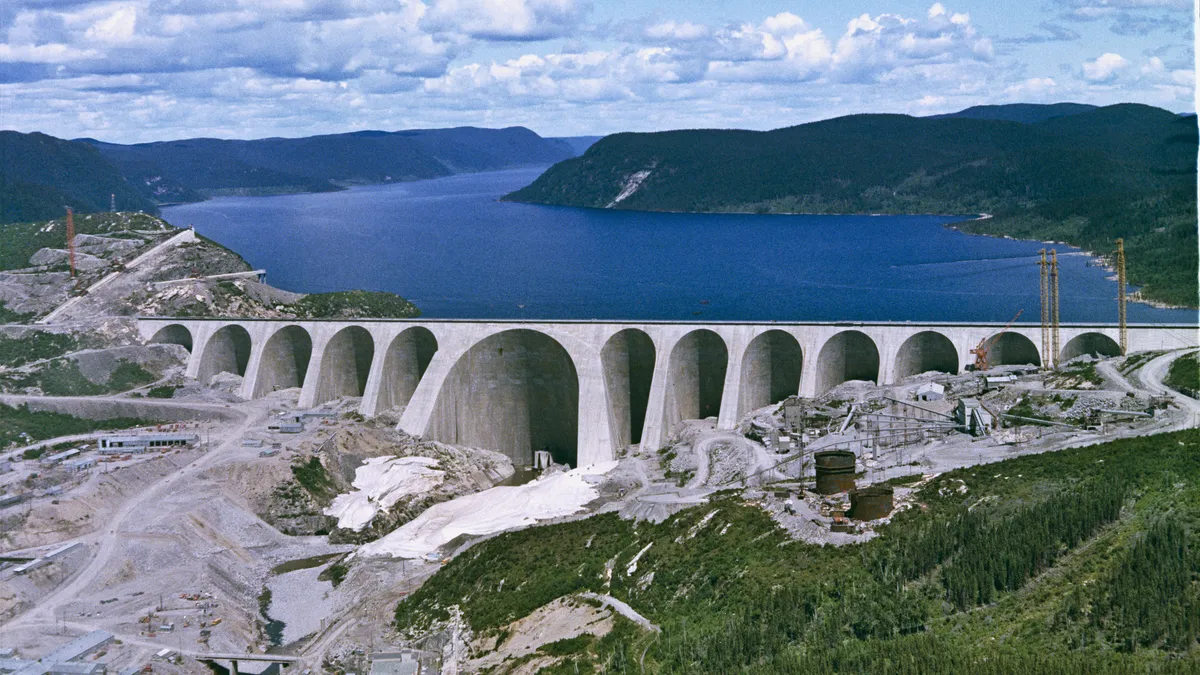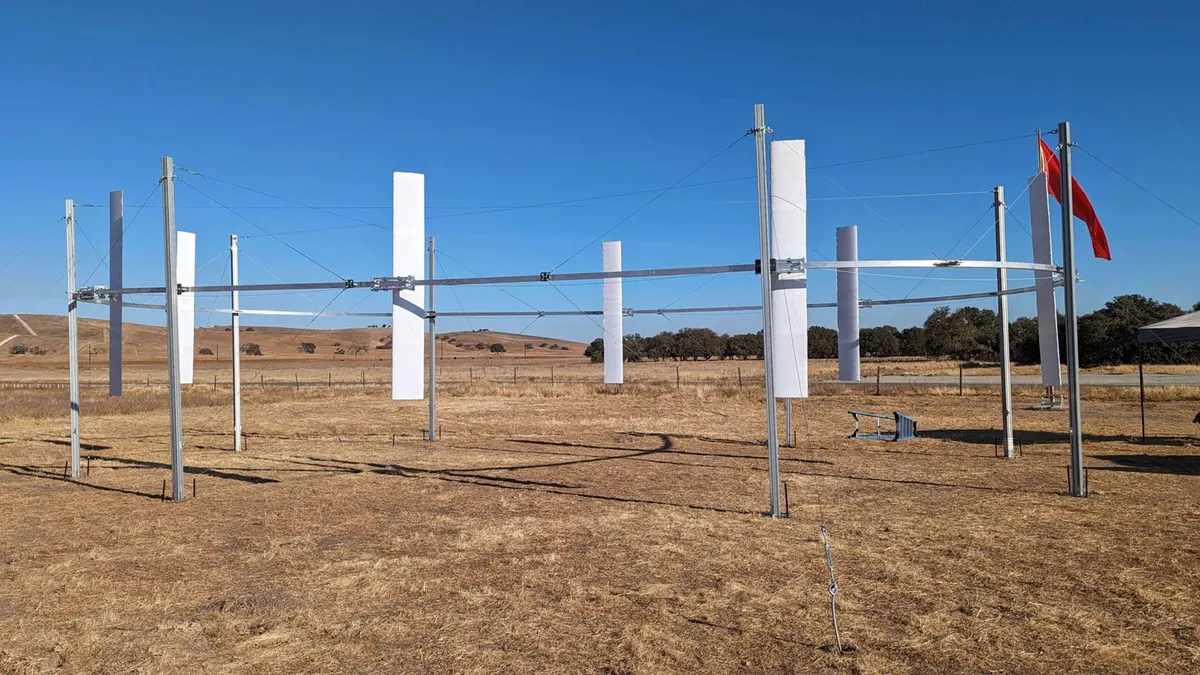With massive reservoirs deep in the northern woods, Québec and other Canadian provinces produce a surplus of hydropower, one of the oldest forms of renewable energy around.
On the other side of the border, in New England and New York, state governments are pushing ahead with ambitious plans to decarbonize their power grids.
Pairing up surplus Canadian hydropower with demand from renewable power-hungry utilities in New York, Massachusetts and other states would seem to be a pragmatic and maybe even a compelling move as the fight to combat climate change takes on a new urgency.
Nor is it a one-way street, with public utility Hydro-Québec interested in buying solar and wind power when the whims of nature provide a surplus, and storing that power in its reservoirs.
"This is where we see the market moving, toward intermittent renewable assets," said Serge Abergel, communications director for Hydro-Québec.
A new study by the National Renewable Energy Laboratory sees hydro playing a key role in the decarbonization of the North American power grid. U.S. Secretary of Energy Jennifer Granholm and Canadian Minister of Natural Resources Seamus O'Regan unveiled the study at a June 24 meeting, while also inking an updated and revised energy cooperation agreement aimed at accelerating efforts to clean up the continent's power grid.
Michelle Manary, acting deputy assistant secretary for energy resilience in the Office of Electricity at the Department of Energy, said that meeting the Biden administration's goal of decarbonizing the power sector by 2035 will require tapping into a broad range non-emitting energy sources, including Canadian hydro.
"It means you are going to need a lot of clean energy to displace or retire the dirty stuff," Manary told Utility Dive in an interview. "You are going to have to have every clean energy resource available to meet those goals."
But plans that may have looked great on paper are proving to be much more complicated when it comes to implementing them on the ground.
In order to connect that surplus of Canadian hydropower with the U.S. electric grid, Avangrid, the U.S. subsidiary of Spanish power giant Iberdrola, has taken the lead on two massive transmission projects.
Central Maine Power, an Avangrid subsidiary, has begun work on a 145-mile transmission corridor through the woods of Western Maine. Named New England Clean Energy Connect (NECEC), the project, slated for completion in 2022, will transmit Québec hydropower to the electric grid in Massachusetts.
Meanwhile, Hydro-Québec has teamed up with Transmission Developers Inc. on another big project, the Champlain Hudson Power Express, which would ferry electricity from Québec to New York City.
However, the Maine project faces intense opposition, with critics raising concerns about disruption to wildlife and disputing hydropower's environmental benefits. A referendum, slated to appear on the state ballot this fall, could throw a monkey wrench into the NECEC transmission project, if not stop it in its tracks.
A recent decision by a Superior Court justice in Maine has further complicated matters, ruling that Gov. Janet Mills', D, administration did not follow the required procedure before leasing state lands for the transmission project.
Criticism in New York of the environmental credentials of the Hydro-Québec proposal has been bubbling as well, though it has not been as intense as in Maine, possibly in part because of a century-long reliance on hydropower in New York, said Julie Tighe, president of the New York League of Conservation Voters.
While there is public support in general for hydropower, people "would rather not see a transmission line," Hydro-Québec's Abergel said.
An ideal marriage?
In a recent report, the Center for Climate and Energy Solutions (C2ES) argues building additional transmission capacity between the Canadian and U.S. grids could have two major benefits.
First, Canada's "comparatively clean mix" of energy could help both the U.S. overall as well as individual cities and states meet their clean energy goals, according to the nonprofit environmental organization.
The vast majority of electricity generated in Canada — about 81% — comes from hydropower, nuclear, wind, solar and other non-carbon-emitting sources, compared to 39% in the U.S.
Hydropower by far is Canada's largest renewable source of power, accounting for 60% of all electric generation in the country, a number that rises to more than 90% of the electric market in the hydropower rich provinces of Québec, British Columbia and Manitoba, the C2ES report finds.
A second potentially major benefit of hydropower is its ability to act as a storage resource when coupled with wind and solar.
Hydropower plants can help store excess wind and solar power by using the power generated by these renewable sources to pump water from a lower reservoir to a higher one. The water in the upper reservoir can then be released later, during a time of peak need, to generate electricity.
A transmission line that went online in June 2020 connected hydropower from Manitoba Hydro to customers at Minnesota Power, helping the Minnesota utility to "back up variable wind power (sited in North Dakota) with hydropower and send any excess wind power to Manitoba," the C2ES report notes.
A similar system can be found in Denmark, where more variable wind power farms are backed up by hydropower resources to the north in Norway and Sweden.
Hydro key to decarbonizing North American grid
The National Renewable Energy Laboratory's in-depth study from June examines how closer cooperation among the U.S., Canada and Mexico could help cut emissions on the North American grid by nearly 80% by 2050.
One of the key scenarios, "Low-Cost VG," short for low-cost variable generation, relies heavily on new solar and wind projects across North America to lower emissions by 78% by 2050.
The scenario envisions steady improvements in the technology behind wind and solar that, in turn, steadily bring down the cost of these renewable power sources and effectively zero out the cost of carbon reductions.
In fact, improvements in renewable technology have advanced so rapidly that the 2018 projections of future costs of wind and solar the NREL study relied on now look "conservative" when compared to the most current estimates, to be found in the NREL Annual Technology Baseline for 2020, said Greg Brinkman a member of the Grid Systems Group in the Strategic Energy Analysis Center of NREL.
But hydro plays a key, stabilizing force in this scenario, providing "operational flexibility," or the ability to adjust the flow of power as needed.
Without the flexibility provided by hydropower to offset the variable loads of solar and wind, operating costs for the U.S. and Canadian grids would be $2.3 billion higher each year, the NREL study finds.
"Hydropower provides a zero-carbon source of energy, capacity, and flexibility to the grid," the study notes.
Building additional transmission could further boost hydropower's operational value as well as bolster efforts to fully develop the potential of new renewable sources of power that will be coming online in the years ahead.
However, Brinkman said that scenario is predicated in part not just on existing transmission, but on new transmission projects connecting regions with hydropower resources to regions with wind and solar as well.
"Although our study didn't explicitly determine the importance of hydro and transmission expansion together, it's logical to conclude that hydro flexibility would have less value if there's not enough transmission," he said.
Increasing the existing transmission infrastructure across the U.S. and Canada, inside both countries on a regional level as well as between them, could yield up to $180 billion in savings over the next three decades, according to the NREL study. Added transmission lines between Canada and the U.S. could save anywhere from $10 billion to $30 billion.
Cost benefits come from a variety of sources — from the increased ability to connect new wind power projects to the grid, to the lowered need to build new gas-fired power plants.
But in order to reap those benefits, additional transmission infrastructure would have to be built in states and provinces along the northern border. And that includes Maine, with the model used by researchers at NREL including additional transmission in the state beyond the NECEC project, Brinkman said.
However, building the transmission lines needed to funnel surplus Canadian hydropower to the U.S., as well as shuttle other sources of renewable power back and forth across the northern border, is not an easy task, as can be seen in the pitched battle over the NECEC project in Maine and the budding debate in New York over the Champlain Hudson Power Express project.
Battle in Maine, skepticism in New York
At first glance, Central Maine Power's New England Clean Energy Connect project, designed to pump Québec hydropower into the New England grid, would appear to be just about a done deal.
The $1 billion project has lined up all its state and federal permits and has withstood federal court challenges, with crews beginning work in the woods of Western Maine earlier this year.
The project is being paid for by ratepayers in Massachusetts, with the Québec hydropower meant to help the state meet its 2050 goal of net zero emissions.
All told, the transmission project would combine 53 miles of new corridor, blazed through what the Natural Resources Council of Maine calls "the largest contiguous temperate forest in North America," along with 92 miles of existing lines.
But the NECEC is now fighting for its life.
In the most recent setback, Maine Superior Court Justice Michaela Murphy ruled Aug. 10 that the director of the state's Bureau of Public Lands had failed to make a determination before awarding the leases to the transmission project whether the public land in question would either be "reduced," or "substantially altered" by the work.
The determination is required under the state constitution, and, if it found that the public acreage is either reduced in size or substantially altered, then a two-thirds vote of the state legislature is needed to move forward, according to the ruling.
"We are reviewing the Superior Court's decision to determine our next steps on this matter," said Thorn Dickinson, CEO/president of NECEC Transmission, in a statement.
Meanwhile, a referendum set to go before Maine voters in November could also decide the project's fate.
The Maine Supreme Judicial Court last year struck down an earlier version of the referendum that would have had voters provide a simple yes or no vote on the project by ordering state regulators to overturn their earlier decision to approve the project.
Instead, the new referendum would mandate a two-thirds vote by the Maine Legislature in order to allow construction of any "high-impact transmission lines" in the state, while retroactively extending this requirement back six years to cover the NECEC project.
The Maine Supreme Judicial Court on July 29 rebuffed a bid to split the referendum into three separate questions, siding with backers of the anti-transmission project question, who had opposed such a move.
Both sides have raised millions from industry heavyweights, with fossil-fuel-powered utilities in Maine backing the referendum campaign and Hydro-Québec helping finance efforts to defeat it.
Sandi Howard, executive director of No CMP Corridor, a political action committee campaigning for the referendum, is a registered Maine guide living in Western Maine.
Howard said she is concerned about the impact the transmission project will have on tourism in Western Maine, where people are drawn from around the country to the area's unspoiled beauty.
Eliminating tree cover, for example, could raise temperatures in local lakes and rivers and potentially endanger the region's reputation as one of the last strongholds of native brook trout, Howard said.
She is also worried about the potential impact on migrating deer and birds.
A spokesperson for NECEC disputed that characterization of the hydropower transmission project.
"The most direct threat is climate change and this project directly addresses that issue," the spokesperson said. "It is going to take millions of metric tons of carbon out of the air in Maine and the region."
Howard said she is also skeptical of claims that boosting the use of hydropower will reduce greenhouse gas emissions, arguing the large reservoirs on which hydropower depends release methane into the atmosphere.
"There is no scientific evidence this power will help reduce global climate change," Howard said.
Such claims, though, don't hold water scientifically, contends Hydro-Québec spokesperson Abergel.
In more southerly climates, rotting vegitation in reservoirs can release methane. But the hydropower giant's reservoirs are in northern latitudes where the water is cold and plants that would decay and emit methane are sparse.
"Boreal reservoirs like ours … very little organic matter falls into the reservoir. We are well oxygenated, and more than half the year it is frozen," Abergel said.
The Hydro-Québec communications chief is helping oversee a multi-million dollar campaign in Maine to get out what he contends are the facts on the NECEC project.
"Our strategy remains the same ... to provide factual information as to the benefits that northern hydropower can bring."
Questions about how environmentally friendly hydropower truly is have been raised in New York, where Hydro-Québec has teamed up on a proposal to build the Champlain Hudson Power Express.
The 338-mile-long transmission line would run under the waters of both Lake Champlain and the Hudson River – from the Canadian border to New York City.
Annel Hernandez, associate director of the New York City Environmental Justice Alliance (NYC-EJA), is concerned about how much of a reduction in emissions hydropower can bring about compared to other renewable sources of energy.
Hernandez said her organization would rather see New York City decarbonize its grid by relying on wind and solar projects developed in the state as well with offshore wind farms.
And the organization "stands in solidarity" with First Nations peoples in Canada who have expressed opposition to the use of Hydro-Québec reservoirs in their territories to produce electricity for New York City.
"We don’t want to be importing energy from other countries," Hernandez said. "We want to make sure we are building the renewable energy we need in New York State."
However, 1,250-megawatt line would provide a burst of badly needed renewable power to the Big Apple, where fossil-fuel power plants continue to provide most of the city's electricity, according to Tighe of the New York League of Conservation Voters.
The project is not a done deal yet, with New York officials expected to pick from a number of proposals later this year.
Still, if the Champlain Hudson Power Express wins the nod, Tighe doesn't expect a rerun of the intense opposition seen in Maine.
New York has relied on hydropower for a century now, with the majority of the electricity needs in Upstate New York currently provided by the resource. And the state already relies on hydropower from Canada, in addition to hydropower generated in the state itself, she said.
"Every project is going to require new power lines – transmission is inevitable and needs to be part of the mix to get more clean energy into New York City," Tighe said. "We have way too many fossil-fuel plants in New York City."
One mitigating factor that could lower opposition to Champlain Hudson Power Express, at least compared to the overland transmission corridor under construction in the Maine woods, is where the transmission line will actually be built, in this case, underneath Lake Champlain and the Hudson River.
Regulators and elected leaders, as they weigh plans to decarbonize the power grid in the U.S. and Canada, will need to consider burying transmission lines and other measures as well in order to win needed public approval for this expansion, said Doug Vine, director of energy analysis at C2ES.
While potentially necessary to win public support, it won't be easy, said Vine, noting that burying transmission lines underground can be as much as ten times more expensive.
C2ES also proposes building transmission infrastructure along existing transportation corridors, using 'Smart from the Start' criteria to strategically pick transmission locations with an eye to avoiding major opposition, and recommends the Federal Energy Regulatory Commission develop a long-term infrastructure strategy for the nation.
As it stands now, it takes on average eight to 10 years to get a new transmission line in place, and that's when everything goes well, according to Vine.
"Transmission is very important — it's really the enabling technology and it is important within the U.S. and it's important for international cooperation as well," Vine said.
Still, it doesn't necessarily have to take so long, said Chris Lawrence, a program and management analyst at the Department of Energy.
Lawrence said a key lesson learned from one recent cross-border transmission project is the importance of early discussions with key stakeholders in a project before starting the official permitting process.
Just take the case of the cross-border transmission line that went online in June 2020, connecting hydropower from Manitoba Hydro to customers at Minnesota Power.
The two utilities began the permitting process in the spring of 2014 and received a green light just two and half years later in the fall of 2016. By 2020, the project was up and running, Lawrence said.
But paving the way for that approval, Manitoba Hydro and Minnesota Power held over 60 stakeholder engagement meetings before even submitting their first regulatory application, according to Lawrence.
"We stress the importance of stakeholder engagement, of going in and asking questions and getting meaningful feedback from the public and explaining why a project needs to happen and why it has to go in the area it needs to go in," Lawrence said.





















